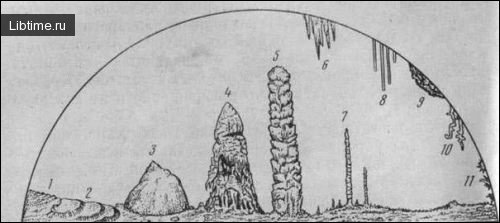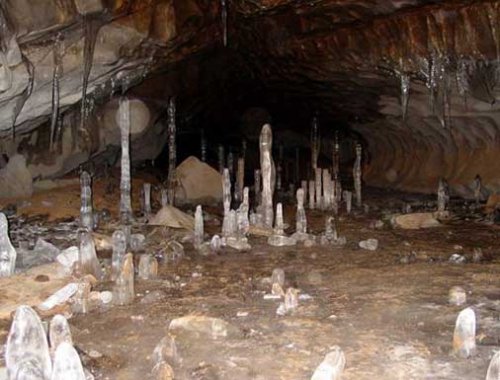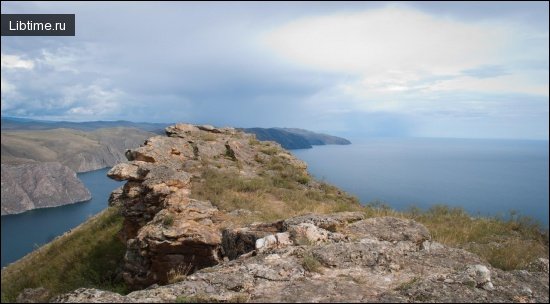The animal world of the caves
Low temperatures, high air humidity and lack of light have determined a special complex of cave fauna. This fauna, occupying a significant part of the lithosphere, is very specific and quite rich in the number of species. 
Troglobionts are of particular interest. These animals are devoid of visual organs and are almost colorless. In conditions of complete darkness, their eyes have been reduced, but the organs of touch and smell have developed considerably.
The life cycles of many cave animals lack seasonal periodicity. For example, there are no annual rings on the shells of mollusks, which indicates their continuous growth throughout the year.
Only in heavily watered caves some aquatic animals show seasonal peculiarities of growth and reproduction. This is due to changes in the water level and, consequently, changes in the abundance and composition of food.
Troglobionts have adapted to high humidity. Many terrestrial animals (spiders, millipedes, mosses) can crawl along the bottom of water bodies for long periods of time, while water dwellers often go on land.
Cave animals feed mainly on bacteria, mold fungi, bat droppings, and organic remains brought into the cave by water. There are predators among them.
Among troglobionts there are many relict forms. During the great glaciations, these animals went into caves and for many millennia almost unchanged. Studying them allows us to more accurately restore some links in the evolution of the animal world of our Earth.
Diversity of the animal world of caves
The animal world of caves belong to the most diverse groups of animal life. Currently, 462 species of cave animals are known on the territory of the Soviet Union, of which 183 are troglobionts. These are mainly inhabitants of water.
There are relatively few terrestrial forms, which is obviously connected with the peculiarities of geological development of the territory and, first of all, with the unfavorable influence of Quaternary glaciations. The fauna of caves on the southern slope of the Greater Caucasus is best studied.
Here, such typical troglobionts as planktonic cyclops, nine-legged trichoniscus, shrimp, false scorpions, beetles and spiders were found in Vorontsovskaya, Akhunskaya, Novo-Afonskaya, Anakopiyskaya, Adzaba, Tsebeldinskaya and Lower Shakuranskaya caves.
According to the peculiarities of distribution and history of development of cave fauna within the former Soviet Union, two latitudinal zones are distinguished: the northern temperate zone, covering Central Russia, the Urals, and Siberia, and the southern temperate zone, including the Crimea, the Caucasus, the southeast of the Russian Plain, Central Asia, and the Far East.
The northern zone is characterized by an unusually poor and monotonous speleofauna, represented exclusively by aquatic troglobionts with a very wide distribution, which reduces their indicative significance.
The evolution of this faunistic complex was significantly influenced by glaciation, which created extremely unfavorable conditions for the formation and preservation of cave fauna.
The southern zone is characterized by a significant richness and diversity of cave animals, which are divided into two zoogeographic complexes - Mediterranean and East Asian - based on genetic links with the centers of speleofauna formation (Levushkin, 1965).
Troglobionts of the southern zone are represented by both aquatic and terrestrial species. Among troglophiles especially interesting are bats, which are found in almost all caves of the USSR.
Bats spend the winter in deep sleep, hanging from the ceiling or walls of caves. They can sleep at temperatures not lower than 2°, only ushans and northern leatherback bats can withstand the cold down to - 4°.
The peculiarity of winter sleep of bats lies in the rapid transition of animals from torpor to activity and back. A light noise or bright light is enough to wake up the animal and fly away.
As observations have shown, winter sleep of bats is regularly interrupted by short periods of wakefulness, and by spring cases of waking up of animals become more frequent.
In spring, females are the first to wake up and leave the cave, followed by males about a month later. In summer, some bats continue to live in the cave, while others fly many dozens of kilometers away from their winter shelter.
A remarkable property of bats is their ability to "see" in the dark. This ability is based on ultrasonic sensing.
Cave microorganisms
Microorganisms are found in cave sediments, in water and in the air of underground cavities. Thus, 1 g of clay in different grottoes of the Kungur Ice Cave contains from 10 thousand to 500 thousand microbes, i.e. 1000 times less than in 1 g of soil on the surface of the Earth. Most of all bacteria are contained in moist underground silt.
In the water and in the air of caves, especially in winter, microorganisms are also very few. The content of microbes in the air of the Kungur cave in different parts of the cave varies from 140 to 6020 in 1 m3.
Consequently, in terms of bacterial content, cave air approaches the pure air of forests and upper atmosphere (Maksimovich, 1963). Faunistic studies of caves have not only great scientific but also important applied significance.
Developing in conditions of considerable isolation, cave animals act as reliable indicators of certain physiographic, geological and hydrogeological conditions.
In particular, the strict confinement of troglobionts to isolated groundwater basins makes it possible to establish hydrogeological links between individual systems of underground cavities using endemic forms. Analysis of individual components of underground landscapes shows their great diversity, significant variability and complex structural combination.
This determines the originality of cave complexes, their individuality. At the same time, underground complexes have much in common and can be united into different types, the regularities of their distribution on the earth's surface are still insufficiently studied.
The greatest importance in recent years are acquiring issues of geochemistry of underground karst landscapes, associated with the study of redistribution of mineral substances in the karst massif and especially the migration of trace elements.
Among the studies devoted to the geochemistry of sulfate karst, the work of K. A. Gorbunova and A. M. Kropachev (1972) stands out. It deals with the peculiarities of strontium migration in the area of the Kungurskaya cave formed in Lower Permian gypsums and anhydrites containing small thicknesses of dolomites and limestones.
On the basis of spectral analysis of a large number of samples (196) it was found that the average strontium content in gypsums is (in %) 0.14, in anhydrites - 0.2, in dolomites - 0.001, in infiltration waters seeping into the cave through the thickness of sulfate rocks with a thickness of about 70 meters,- more than 1, in waters of underground lakes - more than 1 (from 1 to 3), in hydrogenic ice (stalactites, stalagmites, cover ice) - 1, in sublimation ice (ice crystals) - 0, in cave clay - 0.009, in chemogenic formations - 0.1.
The low strontium content in dolomites is obviously explained by its intensive removal from low thickness and significantly karsted interlayers and packs of carbonate sediments enclosed in sulfate strata.
The low strontium content (0.009 %) in cave clays, which are a residual product of leaching of karstic rocks, also attracts attention.
However, in comparison with the clays of Divya Cave, confined to limestones of the Lower Permian, it is somewhat higher (by 0.002%), which is probably due to the presence of secondary gypsum crystals in the clays of Kungurskaya Cave, the strontium content of which reaches 0.3%. Strontium was not detected in the melt water of ice crystals at all.
Thus, underground karst landscapes developing in the conditions of sulfate rocks distribution are characterized by a peculiar geohydrochemical situation characterized by the formation of sulfate or sulfate-calcium hydrochemical facies, relatively enriched with strontium.
Karst landscapes are peculiar physical-geographical complexes. They are characterized by geological, hydrogeological, geomorphological, hydrological and bioclimatic features, which allows us to consider karst landscapes as special types of geographical landscapes.


